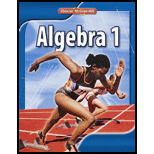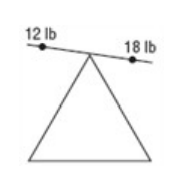
(a)
Draw a picture to represent this situation.
(a)
Answer to Problem 2STP
The right side must be down than the right side
Explanation of Solution
Given:
In a balance have 12 pounds on the left side and 18 pounds on the right side.
Concept Used:
As 12 lbs is less than 18 lbs. So the right side must be down than the right side.

Thus, the right side must be down than the right side as 12 pounds on the left side and 18 pounds on the right side
(b)
Write an inequality.
(b)
Answer to Problem 2STP
12 lbs < 18lbs
Explanation of Solution
Given:
In a balance have 12 pounds on the left side and 18 pounds on the tight side.
Concept Used:
Left side 12 lbs is less than the right side 18 lbs.
Inequality: 12 lbs < 18lbs
Calculation:
Inequality: 12 lbs < 18lbs
Thus, we can write the inequality 12 lbs < 18lbs
(c)
Create a table showing the result of doubling, tripling or quadrupling the weight of each side of the balance.
Create a second table showing the result of reducing the weight on each side of the balance by a factor of 12 ; 13 and 14 . Include a column in each table for the inequality representing each situation.
(c)
Answer to Problem 2STP
Explanation of Solution
Given: In a balance have 12 pounds on the left side and 18 pounds on the tight side.
Concept Used:
Make two tables to represent the situation doubling, tripling or quadrupling the weight of each side of the balance and by a factor of 12 ; 13 and 14 .
Calculation:
Create a table showing the result of doubling, tripling or quadrupling the weight of each side of the balance.
| x | Original | 12 Pound | < | 18 Pound |
| x2 | Doubling | 24 Pound | < | 36 Pound |
| x3 | Tripling | 36 Pound | < | 54 Pound |
| x4 | Quadrupling | 48 Pound | < | 72 Pound |
Create a second table showing the result of reducing the weight on each side of the balance by a factor of 12 ; 13 and 14 . Include a column in each table for the inequality representing each situation.
| x | Original | 12 Pound | < | 18 Pound |
| x12 | by a factor of 12 | 6 Pound | < | 9 Pound |
| x13 | by a factor of 13 | 4 Pound | < | 6 Pound |
| x14 | by a factor of 14 | 3 Pound | < | 4.5 Pound |
Thus, the two tables represent the situations.
(d)
Describe the effect multiplying or dividing each side of an inequality by the same positive value has on the inequality.
(d)
Explanation of Solution
Given: In a balance have 12 pounds on the left side and 18 pounds on the tight side.
Concept Used:
If a true inequality is multiplied by a positive number, the resulting inequality is also true.
If a true inequality is divided by a positive number, the resulting inequality is also true.
Thus, if a true inequality is multiplied by a positive number, the resulting inequality is also true and if a true inequality is divided by a positive number, the resulting inequality is also true.
Chapter 5 Solutions
Algebra 1
Additional Math Textbook Solutions
Pre-Algebra Student Edition
Elementary Statistics (13th Edition)
A First Course in Probability (10th Edition)
University Calculus: Early Transcendentals (4th Edition)
Calculus: Early Transcendentals (2nd Edition)
Using and Understanding Mathematics: A Quantitative Reasoning Approach (6th Edition)
- 7) Solve the given system using the Gaussian Elimination process. (5x-4y = 34 (2x - 2y = 14arrow_forward33 (a) (b) Let A(t) = = et 0 0 0 cos(t) sin(t) 0-sin(t) cos(t)) For any fixed tЄR, find det(A(t)). Show that the matrix A(t) is invertible for any tЄ R, and find the inverse (A(t))¹.arrow_forwardUse the infinite geometric sum to convert .258 (the 58 is recurring, so there is a bar over it) to a ratio of two integers. Please go over the full problem, specifying how you found r. Thank you.arrow_forward
- H.w: Find the Eigen vectors for the largest Eigen value of the system X1+ +2x3=0 3x1-2x2+x3=0 4x1+ +3x3=0arrow_forwardneed help with 5 and 6 pleasearrow_forward1) Given matrix A below, answer the following questions: a) What is the order of the matrix? b) What is the element a13? c) What is the element a₁₁? 4 -1arrow_forward
- [25 points] Given the vector let v = ER² and the collection of vectors ε = E-{)·()}-{☹) (9)} = {(A)·(9)}· B: = and C = · {(6)·(})}· answer the following question. (a) (b) (c) (d) (e) verify Verify is a basis for R² and find the coordinate [] of under ε. Verify B is a basis for R2 and find the coordinate []B of ʊ Verify C is a basis for R2 and find the coordinate []c of under ε. under ε. Find the change-of-basis matrix [I]+B from basis B to basis ε, and EE+BUB Find the change-of-basis matrix [I]B+ε from basis Ɛ to basis B, and verify [U]B= [] B+EVEarrow_forwardExplain the following terms | (a) linear span (b) dimension of vector space (c) linearly independent (d) linearly dependent (e) rank of matrix Aarrow_forward3. Let u = 3/5 √ = and = -4/5 -() Define V span{ū, }. (a) (b) (c) Show that {u, } is orthonormal and forms a basis for V. Explicitly compute Projy w. Explicitly give a non-zero vector in V+.arrow_forward
- Is 1.1 0.65 -3.4 0.23 0.4 -0.44 a basis for R3? You must explain your answer 0arrow_forwardFind the values of x and y in the following scalar multiplication. 8 2 x 1 3 || y = 9 LY_ Show Calculatorarrow_forwardA professor gives two types of quizzes, objective and recall. He plans to give at least 15 quizzes this quarter. The student preparation time for an objective quiz is 15 minutes and for a recall quiz 30 minutes. The professor would like a student to spend at least 5 hours total (300 minutes) preparing for these quizzes. It takes the professor 1 minute to grade an objective quiz, and 1.5 minutes to grade a recall type quiz. How many of each type of quiz should the professor give in order to minimize his grading time (why still meeting the other requirements outlined)?arrow_forward
 Algebra and Trigonometry (6th Edition)AlgebraISBN:9780134463216Author:Robert F. BlitzerPublisher:PEARSON
Algebra and Trigonometry (6th Edition)AlgebraISBN:9780134463216Author:Robert F. BlitzerPublisher:PEARSON Contemporary Abstract AlgebraAlgebraISBN:9781305657960Author:Joseph GallianPublisher:Cengage Learning
Contemporary Abstract AlgebraAlgebraISBN:9781305657960Author:Joseph GallianPublisher:Cengage Learning Linear Algebra: A Modern IntroductionAlgebraISBN:9781285463247Author:David PoolePublisher:Cengage Learning
Linear Algebra: A Modern IntroductionAlgebraISBN:9781285463247Author:David PoolePublisher:Cengage Learning Algebra And Trigonometry (11th Edition)AlgebraISBN:9780135163078Author:Michael SullivanPublisher:PEARSON
Algebra And Trigonometry (11th Edition)AlgebraISBN:9780135163078Author:Michael SullivanPublisher:PEARSON Introduction to Linear Algebra, Fifth EditionAlgebraISBN:9780980232776Author:Gilbert StrangPublisher:Wellesley-Cambridge Press
Introduction to Linear Algebra, Fifth EditionAlgebraISBN:9780980232776Author:Gilbert StrangPublisher:Wellesley-Cambridge Press College Algebra (Collegiate Math)AlgebraISBN:9780077836344Author:Julie Miller, Donna GerkenPublisher:McGraw-Hill Education
College Algebra (Collegiate Math)AlgebraISBN:9780077836344Author:Julie Miller, Donna GerkenPublisher:McGraw-Hill Education





